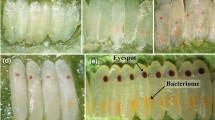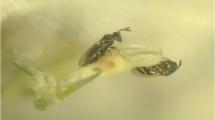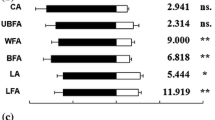Abstract
Hymenopteran parasitoids generally reproduce by arrhenotoky, in which males develop from unfertilized eggs and females from fertilized eggs. A minority reproduce by thelytoky, in which all-female broods are derived from unfertilized eggs. Thelytokous populations are potentially of interest for augmentative biological control programs since the exclusive production of females could significantly lower the costs of mass rearing. Behavioral traits are a major component of parasitoid efficacy. Here, we examined orientation and host searching behavior in thelytokous and arrhenotokous populations of the fruit fly parasitoid Odontosema anastrephae Borgmeier (Hymenoptera: Figitidae). Orientation behavior to various odorant sources was studied in a two-choice olfactometer. No major differences were found between thelytokous and arrhenotokous wasps for this behavior. However, when host-searching behaviors were analyzed, some differences were found. Thelytokous females arrived sooner, foraged longer, and remained longer on non-infested guavas than arrhenotokous females. Individuals of both forms exhibited similar stereotyped behavioral sequences vis-à-vis guava treatments, with only slight deviations detected. Our results suggest that individuals from selected thelytokous and arrhenotokous O. anastrephae populations have similar abilities to search for tephritid larvae, supporting the use of thelytokous strains for augmentative releases.






Similar content being viewed by others
References
Aeschlimann J-P (1990) Simultaneous occurrence of thelytoky and bisexuality in hymenopteran species, and its implications for the biological control of pests. Entomophaga 35:3–5
Aluja M (1994) Bionomics and management of Anastrepha. Annu Rev Entomol 39:155–178
Aluja M (1999) Fruit fly (Diptera: Tephritidae) research in Latin America: myths, realities and dreams. Ann Entomol Soc Brazil 28:565–594
Aluja M, Mangan RL (2008) Fruit fly (Diptera: Teprhitidae) host status determination: Critical conceptual, methodological, and regulatory considerations. Annu Rev Entomol 53:473–502
Aluja M, Lopez M, Sivinski J (1998) Ecological evidence for diapause in four native and one exotic species of larval-pupal fruit fly (Diptera: Tephritidae) parasitoids in tropical environments. Ann Entomol Soc Am 91:821–833
Aluja M, Ovruski SM, Guillén L, Oroño LE, Sivinski J (2009a) Comparison of the host searching and oviposition behaviors of the tephritid (Diptera) parasitoids Aganaspis pelleranoi and Odontosema anastrephae (Hymenoptera: Figitidae, Eucoilinae). J Insect Behav 22:423–451
Aluja M, Sivinski J, Ovruski S, Guillen L, Lopez M, Cancino J, Torres-Anaya A, Gallegos-Chan G, Ruiz L (2009b) Colonization and domestication of seven species of native new world hymenopterous larval-prepupal and pupal fruit fly (Diptera: Tephritidae) parasitoids. Biocontrol Sci Techn 19:49–80
Amat I, Castelo M, Desouhant E, Bernstein C (2006) The influence of temperature and host availability on the host exploitation strategies of sexual and asexual parasitic wasps of the same species. Oecologia 148:153–161
Amat I, Desouhant E, Bernstein C (2009) Differential use of conspecific-derived information by sexual and asexual parasitic wasps exploiting partially depleted host patches. Behav Ecol Sociobiol 63:563–572
Arakaki N, Oishi K, Noda H (2001) Parthenogenesis induced by Wolbachia in Gronotoma micromorpha (Hymenoptera: Eucoilidae). Entomol Sci 4:9–15
Ardeh MJ, de Jong PW, van Lenteren JC (2005a) Selection of Bemisia nymphal stages for oviposition or feeding, and host-handling times of arrhenotokous and thelytokous Eretmocerus mundus and arrhenotokous E-eremicus. BioControl 50:449–463
Ardeh MJ, de Jong PW, van Lenteren JC (2005b) Intra- and interspecific host discrimination in arrhenotokous and thelytokous Eretmocerus spp. Biol Control 33:74–80
Burns RE, Harris DL, Moreno DS, Eger JE (2001) Efficacy of spinosad bait sprays to control Mediterranean and Caribbean fruit flies (Diptera: Tephritidae) in commercial citrus in Florida. Fla Entomol 84:672–678
Copeland CS, Hoy M, Jeyaprakash A, Aluja M, Ramirez-Romero R, Sivinski J (2010) Genetic characteristics of bisexual and female-only populations of Odontosema anastrephae (Hymenoptera: Figitidae). Fla Entomol 93:437–443
Crawley MJ (2007) The R Book. John Wiley & Sons Ltd, West Sussex
Field SA, Keller MA (1993) Courtship and intresexual signaling in the parasitic wasp Cotesia rubecula (Hymenoptera, Braconidae). J Insect Behav 6:737–750
Floate KD, Kyei-Poku GK, Coghlin PC (2006) Overview and relevance of Wolbachia bacteria in biocontrol research. Biocontrol Sci Technol 16:767–788
Godfray HCJ (1994) Parasitoids behavioral and evolutionary ecology. Princeton University Press, Princeton
Grenier S, De Clercq P (2003) Comparison of artificially vs. naturally reared natural enemies and their potential for use in biological control. In: van Lenteren JC (ed) Quality control and production of biological control agents theory and testing procedures. CABI Publishing, Wallingford, pp 115–131
Guillot C (2005) Entomology. Springer, Dordrecht
Heimpel GE, de Boer JG (2008) Sex determination in the Hymenoptera. Annu Rev Entomol 53:209–230
Hohmann CL, Luck RF, Stouthamer R (2001) Host deprivation effect on reproduction and survival of Wolbachia-infected and uninfected Trichogramma kaykai Pinto & Stouthamer (Hymenoptera: Trichogrammatidae). Neotrop Entomol 30:601–605
Huigens M, Stouthamer R (2003) Parthenogenesis associated with Wolbachia. In: Bourtzis K, Miller T (eds) Insect symbiosis. CRC Press, Boca Raton
Knipling EF (1979) The basic principles of insect population suppression and management. USDA-ARS Handbook #512
Lehner PN (1996) Handbook of ethological methods. Cambridge University Press, Cambridge
Lewis WJ, Vet LEM, Tumlison JH, van Lenteren JC, Papaj DR (1990) Variations in parasitoid foraging behavior: essential element of a sound biological control theory. Environ Entomol 19:1183–1193
Liquido N, Shinoda L, Cunningham R (1991) Host plants of the Mediterranean fruit fly, Ceratitis capitata (Wiedemann) (Diptera: Tephritidae): an annotated world review. Misc. Pub. #77. Entomological Society of America, Lanham
Lopez M, Aluja M, Sivinski J (1999) Hymenopterous larval-pupal and pupal parasitoids of Anastrepha flies (Diptera: Tephritidae) in Mexico. Biol Control 15:119–129
Luck RF, Stouthamer R, Nunney L (1993) Sex determination and sex ratio patterns in parasitic Hymenoptera. In: Wrensch DL, Ebbert MA (eds) Evolution and diversity of sex ratio in haplodiploid insects and mites. Chapman and Hall, New York, pp 442–476
Meyhofer R, Casas J (1999) Vibratory stimuli in host location by parasitic wasps. J Insect Physiol 45:967–971
Miura K, Tagami Y (2004) Comparison on life history characters of arrhenotokous and Wolbachia-associated thelytokous Trichogramma kaykai Pinto & Stouthamer (Hymenoptera: Trichogrammatidae). Ann Entomol Soc Am 97:765–769
Mondor EB, Roland J (1998) Host searching and oviposition by Leschenaultia exul, a tachinid parasitoid of the forest tent caterpillar, Malacosoma disstria. J Insect Behav 11:583–592
Montoya P, Liedo P, Benrey B, Cancino J, Barrera JF, Sivinski J, Aluja M (2000) Biological control of Anastrepha spp (Diptera: Tephritidae) in mango orchards through augmentative releases of Diachasmimorpha longicaudata (Ashmead) (Hymenoptera: Braconidae). Biol Control 18:216–224
Navasero R, Elzen G (1991) Sensilla on the antennae, foretarsi and palpi of Microplitis croceipes (Cresson) (Hymenoptera: Braconidae). P Entomol Soc Wash 93:737–747
Nogge G, Gerresheim A (1982) Experiments on the elimination of symbionts from the tsetse fly, Glossina morsitans morsitans (Diptera: Glossinidae), by antibiotics and lysozyme. J Invertebr Pathol 40:166–179
Olson DM, Andow DA (2002) Inheritance of an oviposition behavior by an egg parasitoid. Heredity 88:437–443
Ovruski S, Aluja M, Sivinski J, Wharton R (2000) Hymenopteran parasitoids on fruit-infesting Tephritidae (Diptera) in Latin America and the southern United States: diversity, distribution, taxonomic status and their use in fruit fly biological control. Integr Pest Manag Rev 5:81–107
Ovruski S, Wharton R, Rull J, Guillen L (2007) Aganaspis alujai (Hymenoptera: Figitidae: Eucoilinae), a new species attacking Rhagoletis in the neotropical region. Fla Entomol 90:626–634
Pannebakker BA (2004) Evolutionary consequences of Wolbachia-induced parthenogenesis in the parasitoid Leptopilina clavipes. PhD Dissertation, Leiden University, Netherlands
Pannebakker BA, Pijnacker LP, Zwaan BJ, Beukeboom LW (2004) Cytology of Wolbachia-induced parthenogenesis in Leptopilinia clavipes (Hymenoptera: Figitidae). Genome 47:299–303
Pannebakker B, Schidlo N, Boskamp G, Dekker L, van Dooren T, Buekeboom L, Zwaan B, Brakefield P, van Alphen J (2005) Sexual functionality of Leptopilina clavipes (Hymenoptera: Figitidae) after reversing Wolbachia-induced parthenogenesis. J Evol Biol 18:1019–1028
Pinheiro JC, Bates DM (2000) Mixed-effects models in S and S-Plus. Springer Verlag, New York
Rendon P, Sivinski J, Holler T, Bloem K, Lopez M, Martinez A, Aluja M (2006) The effects of sterile males and two braconid parasitoids, Fopius arisanus (Sonan) and Diachasmimorpha krausii (Fullaway) (Hymenoptera), on caged populations of Mediterranean fruit flies Ceratitis capitata (Wied.) (Diptera: Tephritidae) at various sites in Guatemala. Biol Control 36:224–231
Rice WR (1989) Analyzing tables of statistical tests. Evolution 43:223–225
Rull J, Reyes J, Enkerlin W (1996) The Mexican national fruit fly eradication campaign: largest fruit fly industrial complex in the world. In: McPheron BA, Steck GA (eds) Fruit fly pests: a world assessment of their biology and management. St. Lucie Press, Delray Beach, pp 561–563
Siebert J (1999) Update on the economic impact of Mediterranean fruit fly on California agriculture. Subtropical Fruit News 7:16–18
Siebert JB, Cooper T (1995) Embargo on California produce would cause revenue, job loss. Calif Agric 49:7–12
Silva IMMS, van Meer MMM, Roskam MM, Hoogenboom A, Gort G, Stouthamer R (2000) Biological control potential of Wolbachia-infected versus uninfected wasps: laboratory and greenhouse evaluation of Trichogramma cordubensis and T. deion strains. Biocontrol Sci Technol 10:223–238
Sivinski JM, Calkins CO, Baranowski R, Harris D, Brambila J, Diaz J, Burns RE, Holler T, Dodson G (1996) Suppression of a Caribbean fruit fly (Anastrepha suspensa (Loew) Diptera: Tephritidae) population through augmented releases of the parasitoid Diachasmimorpha longicaudata (Ashmead) (Hymenoptera: Braconidae). Biol Control 6:177–185
Sivinski J, Aluja M, Lopez M (1997) Spatial and temporal distributions of parasitoids of Mexican Anastrepha species (Diptera: Tephritidae) within the canopies of fruit trees. Ann Entomol Soc Am 90:604–618
Sivinski J, Vulinec K, Menezes E, Aluja M (1998) The bionomics of Coptera haywardi (Ogloblin) (Hymenoptera: Diapriidae) and other pupal parasitoids of tephritid fruit flies (Diptera). Biol Control 11:193–202
Stouthamer R (1993) The use of sexual versus asexual wasps in biological control. Entomophaga 38:3–6
Stouthamer R (1997) Wolbachia-induced parthenogenesis. In: O’Neill SL, Hoffmann AA, Werren JH (eds) Influential passengers: inherited microorganisms and arthropod reproduction. Oxford University Press, Oxford, pp 102–124
Stouthamer R (2003) The use of unisexual wasps in biological control. In: van Lenteren JC (ed) Quality control and production of biological control agents theory and testing procedures. CABI Publishing, Wallingford, pp 93–113
Stouthamer R, Kazmer DJ (1994) Cytogenetics of microbe-associated parthenogenesis and its consequences for gene flow in Trichogramma wasps. Heredity 73:317–327
Stouthamer R, Breeuwer JAJ, Hurst GDD (1999) Wolbachia pipientis: microbial manipulator of arthropod reproduction. Annu Rev Microbiol 53:71–102
Turlings TCJ, Tumlinson JH, Eller FJ, Lewis WJ (1991) Larval-damaged plants—source of volatile synomones that guide the parasitoid Cotesia marginiventris to the microhabitat of its hosts. Entomol Exp Appl 58:75–82
van Lenteren JC (1986) Parasitoids in the greenhouse: successes with seasonal inoculative release systems. In: Waage J, Greathead D (eds) Insect parasitoids. Academic Press, London, pp 342–374
Vargas RI, Peck SL, McQuate GT, Jackson CG, Stark JD, Armstrong JW (2001) Potential for area wide integrated management of Mediterranean fruit fly (Diptera: Tephritidae) with a braconid parasitoid and a novel bait spray. J Econom Entomol 94:817–825
Visotto LE, Oliveira MGA, Guedes RNC, Ribon AOB, Good-God PIV (2009) Contribution of gut bacteria to digestion and development of the velvetbean caterpillar, Anticarsia gemmatalis. J Insect Physiol 55:185–191
Wang XG, Messing RH (2003) Foraging behavior and patch time allocation by Fopius arisanus (Hymenoptera: Braconidae), an egg-larval parasitoid of tephritid fruit flies. J Insect Behav 16:593–612
Wang Q, Gu H, Dorn S (2003) Selection on olfactory response to semiochemicals from a plant-host complex in a parasitic wasp. Heredity 91:430–435
White IM, Elson-Harris MM (1992) Fruit flies of economic significance: their identification and bionomics. CAB International, Wallingford
Wilkinson TL (1998) The elimination of intracellular microorganisms from insects: an analysis of antibiotic-treatment in the pea aphid (Acyrthosiphon pisum). Comp Biochem Physiol 119:871–881
Wong TTY, Ramadan M, McInnis D, Mochizuki N, Nishimoto I, Herr J (1991) Augmentative releases of Diachasmimorpha tryoni (Hymenoptera: Braconidae) to suppress a Mediterranean fruit fly (Diptera: Tephritidae) population in Kula, Maui, Hawaii. Biol Control 1:2–7
Wong TTY, Ramadan MM, Herr JC, McInnis DO (1992) Suppression of a Mediterranean fruit fly (Diptera, Tephritidae) population with concurrent parasitoid and sterile fly releases in Kula, Maui, Hawaii. J Econ Entomol 85:1671–1681
Acknowledgments
We thank two anonymous reviewers and the editor for helping us to produce a more polished final product. We also thank Dr. Nicolas Desneux (INRA-URIH, France) for critical comments on an early version of the manuscript and Dr. Roger Guevara (INECOL, A.C., Mexico) for statistical advice. We thank Cecilia Martinez, Sandy P. Méndez and Nicoleta Righini for technical assistance. This project was funded by grants from the Mexican Campaña Nacional Contra Moscas de la Fruta (DGSV-SAGARPA-IICA) to M. Aluja. Additional funds were provided along the way by grants from the Mexican Consejo Nacional de Ciencia y Tecnología (CONACyT Grant No. 46846-Q [2004–2008]), Mexican Comisión para el Conocimiento y Uso de la Biodiversidad (CONABIO Project H-296), and the Sistema de Investigación Regional del Golfo de México (SIGOLFO-CONACyT, Project 96-01-003-V) to M. Aluja. M. Aluja also acknowledges support from CONACyT through a Sabbatical Year Fellowship (Ref. 79449) and thanks Benno Graf and Jörg Samietz (Forschungsanstalt Agroscope Changins-Wädenswil ACW, Switzerland) for providing ideal conditions to work on this paper. CSC was the recipient of a headquarters postdoctoral fellowship from the United States Department of Agriculture (USDA/ARS). A postdoctoral fellowship to R-RR was provided by the Instituto de Ecología A.C. (INECOL, A.C.) Mexico.
Author information
Authors and Affiliations
Corresponding author
Additional information
Handling Editor: Torsten Meiners
Rights and permissions
About this article
Cite this article
Ramirez-Romero, R., Sivinski, J., Copeland, C.S. et al. Are individuals from thelytokous and arrhenotokous populations equally adept as biocontrol agents? Orientation and host searching behavior of a fruit fly parasitoid. BioControl 57, 427–440 (2012). https://doi.org/10.1007/s10526-011-9413-3
Received:
Accepted:
Published:
Issue Date:
DOI: https://doi.org/10.1007/s10526-011-9413-3




